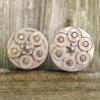This is an excerpt from a report from therevolverguy.com about how they did it.
Quote:
So, it was critical to the Kimber team to marry the popular 6-round cylinder without deviating much from the outer dimensions of S&W’s flagship defensive snubby, the Model 640. Could it be done?
Yes it could. The Kimber team started by offsetting the location where the bolt comes out of the frame to lockup the 6-shot cylinder. This was necessary to maintain the integrity of the cylinder walls, particularly with high pressure .357 Magnum ammunition.
Consider a gun where the bolt window is located in the bottom center of the frame. When the cylinder is in battery, the bolt rises up from the 6 O’Clock position to engage the notch in the cylinder and lock it in place. If the cylinder is a 6-shot cylinder, then that would place the bolt notch directly over the center of the chamber, where the walls are thinnest. This creates a potential structural weakness—a place where high pressure gas could rupture the cylinder wall and escape.
You could solve this problem by increasing the diameter of the cylinder, to ensure that enough material remained after you cut the notch on the outside to safely contain the pressure, but that would require a bigger frame as well. Your small frame would grow larger and the gun would get heavier, to boot. Not ideal.
So Kimber took another approach, and shifted the bolt window outboard on the starboard (right, for you non-nautical types) side. By offsetting the bolt that direction, the notches on the cylinder could be moved so that they wouldn’t fall directly on top of the chambers. Instead, the notch could could be cut over the web that separates adjoining chambers, where the cylinder walls are thickest. This allowed Kimber engineers to safely contain Magnum-level pressures in a cylinder with the smallest outer diameter.
Going one step further, Kimber milled flats on the outside of the cylinder, which reduced the outer diameter. Instead of being a perfect circle, the cylinder now had more of a soft, hexagonal shape. The flats reduced the width of the gun at the point where it’s normally fattest, giving the 6-shot cylinder of the K6s a width on par with the 5-shot S&W Model 640 (1.39” versus the S&W’s 1.31”), as well as an identical weight (23 ounces). Kimber had built a 6-shot J-Frame!
End quote.










